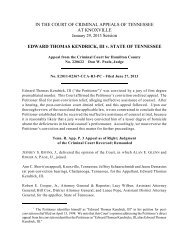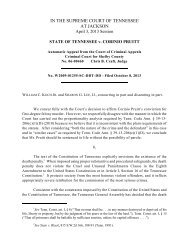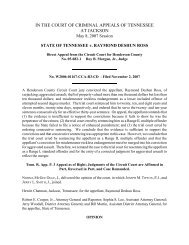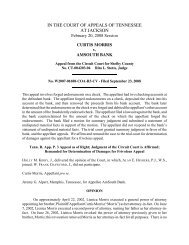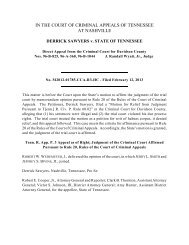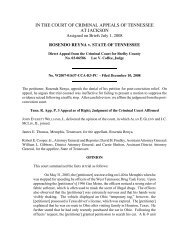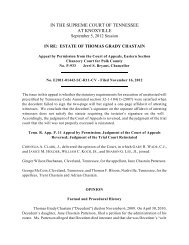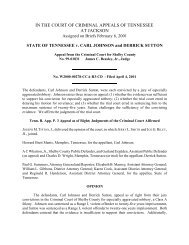STATE OF TENNESSEE v. CHRISTOPHER LEE DAVIS
STATE OF TENNESSEE v. CHRISTOPHER LEE DAVIS
STATE OF TENNESSEE v. CHRISTOPHER LEE DAVIS
Create successful ePaper yourself
Turn your PDF publications into a flip-book with our unique Google optimized e-Paper software.
IN THE COURT <strong>OF</strong> CRIMINAL APPEALS <strong>OF</strong> <strong>TENNESSEE</strong><br />
AT NASHVILLE<br />
Assigned on Briefs April 23, 2013<br />
<strong>STATE</strong> <strong>OF</strong> <strong>TENNESSEE</strong> v. <strong>CHRISTOPHER</strong> <strong>LEE</strong> <strong>DAVIS</strong><br />
Direct Appeal from the Criminal Court for Trousdale County<br />
No. 07-55 John D. Wootten, Jr., Judge<br />
No. M2012-01546-CCA-R3-CD - Filed July 18, 2013<br />
The appellant, Christopher Lee Davis, was convicted of attempted first degree murder, a<br />
Class A felony; aggravated robbery, a Class B felony; carjacking, a Class B felony; and<br />
attempted especially aggravated kidnapping, a Class B felony. On direct appeal, our supreme<br />
court affirmed the appellant’s convictions but remanded for resentencing on the issue of<br />
consecutive sentencing. See State v. Davis, 354 S.W.3d 718, 721-22 (Tenn. 2011). On<br />
remand, the trial court again ordered partial consecutive sentencing, which resulted in an<br />
overall effective sentence of forty-nine years. On appeal, the appellant challenges the<br />
imposition of consecutive sentencing. Upon review, we affirm the judgments of the trial<br />
court.<br />
Tenn. R. App. P. 3 Appeal as of Right; Judgments of the Criminal Court are<br />
Affirmed.<br />
NORMA MCGEE OGLE, J., delivered the opinion of the court, in which JOSEPH M. TIPTON,<br />
P.J., and THOMAS T. WOODALL, J., joined.<br />
William K. Cather, Lebanon, Tennessee, for the appellant, Christopher Lee Davis.<br />
Robert E. Cooper, Jr., Attorney General and Reporter; Sophia S. Lee, Senior Counsel; Tom<br />
P. Thompson, District Attorney General; and Jason Lawson, Assistant District Attorney<br />
General, for the appellee, State of Tennessee.<br />
OPINION<br />
I. Factual Background<br />
On direct appeal, our supreme court summarized the facts adduced at trial as follows:
On June 12, 2007, the victim, Glen McDaniel, drove his<br />
black 2001 Chevrolet Monte Carlo into a carwash bay in<br />
Hartsville, Tennessee. While Mr. McDaniel was washing his<br />
car, he saw a gold Nissan Maxima pull into the carwash and<br />
noticed that the two men in the back of the Maxima were staring<br />
at him. Mr. McDaniel continued washing his car until he was<br />
confronted by two African-American men wearing bandanas<br />
over their faces who entered his carwash bay from opposite<br />
sides. The men wore red shirts and red hats, and one of them<br />
had a hat with a depiction of a $100 bill embroidered on it. Mr.<br />
McDaniel described one of them as approximately six feet, three<br />
or four inches tall and heavy set with dark skin. The other man,<br />
whom Mr. McDaniel identified at trial as being the [appellant].<br />
. . , was nearly the same height but thinner and with a lighter<br />
complexion.<br />
The larger man walked up to Mr. McDaniel, pointed a<br />
pistol at his chest, and told him to get into the Monte Carlo. Mr.<br />
McDaniel complied because he was afraid the man would shoot<br />
him if he refused. The man with the pistol got in the passenger<br />
seat and kept his gun pointed at Mr. McDaniel the entire time<br />
they were in the Monte Carlo. [The appellant] got in the back<br />
seat behind Mr. McDaniel and kept a grip on Mr. McDaniel’s<br />
shoulders. The men asked for $800, and Mr. McDaniel replied<br />
that he did not have that much money on him and that he did not<br />
carry a wallet, but did have an ATM debit card. The men<br />
ordered him to drive across the street to an ATM.<br />
The gunman walked Mr. McDaniel up to the ATM, and<br />
[the appellant] held his hand over one of the ATM video<br />
cameras. [The appellant] told Mr. McDaniel to get a receipt so<br />
they could make sure that he had withdrawn all of the money in<br />
his checking account. Mr. McDaniel completed the ATM<br />
withdrawal and gave the gunman the money and the receipt.<br />
All three got back into the Monte Carlo, and Mr.<br />
McDaniel drove back to the carwash. As they approached, they<br />
saw Lacy Smotherman, an acquaintance of Mr. McDaniel,<br />
sitting in a parked car at the carwash, so the men told Mr.<br />
McDaniel to drive down the street. He did, and when they<br />
-2-
turned the car around and returned to the carwash, Ms.<br />
Smotherman was gone. Mr. McDaniel pulled his car into one of<br />
the carwash bays, and the men ordered him to get out of the car.<br />
[The appellant] pushed Mr. McDaniel against one of the<br />
walls in the carwash bay. Mr. McDaniel asked [the appellant]<br />
to take his car and leave him at the carwash, but [the appellant]<br />
refused, saying, “no, you’re going to go with us.” Mr. McDaniel<br />
testified that at this point, “I thought I was dead to be honest<br />
with you.” He was standing with his chest pressed against the<br />
wall and [the appellant] was trying to pull his hands behind his<br />
back. Mr. McDaniel looked over his shoulder and saw that [the<br />
appellant] had a roll of black duct tape. Mr. McDaniel testified<br />
that “I yanked my hands right back up . . . ‘cause I knew, you<br />
know, if I was duct taped I was done for.” He struggled with<br />
[the appellant], who shoved his face into the brick wall, injuring<br />
his nose and face, and hit him in the eye. [The appellant] said,<br />
“get the gun, we’re going to shoot this motherfucker right here.”<br />
Mr. McDaniel testified that during the incident [the appellant]<br />
appeared to be the one in control of the situation, giving orders<br />
and instructions to the other man.<br />
Mr. McDaniel said that at this point, “I figured if I was<br />
going to get shot, I might as well try to run.” He broke free<br />
from [the appellant’s] grasp and ran toward a nearby restaurant.<br />
[The appellant] chased after him. The restaurant was closed.<br />
Mr. McDaniel ran around the side and headed for a gas station.<br />
He came to a steep embankment and jumped down the slope<br />
into the ditch. As he came over the other side and continued<br />
running toward the gas station, Mr. McDaniel saw his Monte<br />
Carlo pull out of the carwash. He also saw a black Chevrolet<br />
Impala pulling out at the same time. Mr. McDaniel reached the<br />
counter inside the gas station, told the attendant to call the police<br />
because he had just been carjacked and “those guys are trying to<br />
kill me,” and collapsed from exhaustion. The attendant revived<br />
him, and the Sheriff’s Department arrived a few minutes later.<br />
That night, Mr. McDaniel provided a written statement to law<br />
enforcement officers describing the incident.<br />
The next day, Detective Chris Tarlecky of the Sumner<br />
-3-
County Sheriff’s Department received information from<br />
Trousdale County law enforcement to “be on the lookout”<br />
(“BOLO”) for the suspects in the carjacking and robbery. The<br />
BOLO dispatch contained the basic facts of the incident,<br />
described the stolen vehicle as a 2001 black Monte Carlo with<br />
custom wheels, provided a general description of the suspects,<br />
and identified the suspects’ vehicle as a gold Maxima. Later<br />
that day the abandoned Monte Carlo was discovered at the<br />
Bledsoe Creek boat dock. Detective Tarlecky and another<br />
Sumner County Sheriff’s Department officer drove to the boat<br />
dock.<br />
Justin Scruggs, a friend of Mr. McDaniel, first discovered<br />
the Monte Carlo as he and some relatives were driving by the<br />
boat dock. Mr. Scruggs, his mother Tammy Scruggs Reed, and<br />
his uncle Jerry Scruggs pulled into the boat dock area and then<br />
called the Sumner and Trousdale County Sheriff’s Departments.<br />
Mr. McDaniel was notified that his car had been found, and he,<br />
his mother, and his girlfriend also drove to the boat dock area to<br />
identify his car. Detective Tarlecky and the second Sumner<br />
County officer arrived in unmarked Ford Crown Victorias.<br />
Additionally, Trousdale County Sheriff Ray Russell and<br />
Detective David Winnett arrived on the scene shortly thereafter,<br />
driving another unmarked Crown Victoria. Detective Tarlecky<br />
testified that the stolen Monte Carlo’s doors were locked, but<br />
that he could see that the CD player had been removed from the<br />
dashboard. He also observed that the Monte Carlo’s wheels,<br />
which were custom after-market wheels that he valued at around<br />
$2,000, were still on the car and that the car contained several<br />
other potentially valuable items. Mr. McDaniel examined his<br />
car and confirmed that the CD player had been ripped out of the<br />
dashboard and that his rear stereo amplifier was also missing.<br />
Detective Tarlecky stated that as they were inspecting the<br />
stolen car, he and the other officers observed a white Crown<br />
Victoria drive slowly by the boat dock and begin to make a right<br />
turn into the parking area. Detective Tarlecky could see the<br />
driver and passenger, who were African-American males, and<br />
he testified that “their eyes opened as big as saucers when they<br />
saw us and the vehicle just jerked back off on to . . . the<br />
-4-
oadway.” He stated that the turn back on the road “was a<br />
startled movement. They had looked down and saw us and they<br />
abruptly turned back . . . It caught our attention the way they did<br />
it.” The white Crown Victoria continued across the Bledsoe<br />
Creek bridge, then turned into a church parking lot, turned<br />
around, and slowly drove back by the boat dock area again.<br />
Detective Tarlecky got in his vehicle, activated its emergency<br />
lights, and initiated a stop of the Crown Victoria. Detective<br />
Tarlecky identified the driver as James Phillips, and the<br />
passenger as [the appellant]. Mr. Phillips consented to a search<br />
of the vehicle. Detective Tarlecky found a Chevrolet key chain<br />
in the door panel on the driver’s side. He tossed the keys to<br />
Sheriff Russell, who confirmed that the car keys fit the Monte<br />
Carlo. The officers then took Mr. Phillips and [the appellant]<br />
into custody.<br />
The search of the car also revealed several completed job<br />
application forms, one of which had been filled out by Marcus<br />
Bradford and listed an address of 1100 Winwood Drive in the<br />
nearby town of Castalian Springs. Detective Tarlecky went to<br />
the address and spoke with Mr. Bradford, who confirmed that he<br />
lived there, and consented to a search of the common areas of<br />
the house and his bedroom. In the living room, Detective<br />
Tarlecky found a large speaker box and a CD player with part of<br />
a car dashboard attached to it. Detective Tarlecky discovered a<br />
large amplifier of the same brand as Mr. McDaniel’s stolen<br />
amplifier and a blue backpack in the “game room” of the house.<br />
The backpack contained a red hat with a depiction of a $100 bill<br />
embroidered on it, and what Detective Tarlecky described as a<br />
red “doo rag.” Detective Tarlecky also recovered from the<br />
house a wallet with [the appellant’s] identification in it, a red<br />
T-shirt found in the dryer, a blue travel bag containing a roll of<br />
duct tape, and a number of CDs and a black bandana found in<br />
Mr. Bradford’s room.<br />
Mr. Bradford told Detective Tarlecky that Michael Miller<br />
and Michelle Guardiola were the lessees of the house. The<br />
officers contacted Mr. Miller and Ms. Guardiola, who returned<br />
home in a black Chevrolet Impala. Mr. Miller and Ms.<br />
Guardiola consented to a search of the entire house and the<br />
-5-
Impala. In the black Impala, Detective Winnett found a red<br />
T-shirt and what appeared to be car stereo wiring. Sheriff<br />
Russell participated in a second search of the house; he testified<br />
that he discovered a lockbox and that a set of keys fitting the<br />
lockbox were found among the personal items taken from [the<br />
appellant] after his arrest. The lockbox contained a 40mm<br />
semi-automatic pistol and ammunition.<br />
[The appellant] was charged with one count each of<br />
aggravated robbery, carjacking, attempt to commit especially<br />
aggravated kidnapping, and attempt to commit first degree<br />
murder. At the trial, the State presented the videotape recording<br />
from the ATM’s security camera, and Mr. McDaniel identified<br />
the man in the red shirt and red hat as the gunman. Mr.<br />
McDaniel testified that the carwash bays were well-lighted and<br />
that he was able to get a good look at [the appellant] and clearly<br />
see his face. Mr. McDaniel positively identified [the appellant]<br />
as being the man who sat behind him in the Monte Carlo,<br />
pushed him into the carwash bay wall, hit him, tried to duct tape<br />
his hands, and pursued him after he ran.<br />
The State also presented the testimony of Lacey<br />
Smotherman, who said that she was at the carwash on the night<br />
of June 12, 2007, around 10:00 p.m. Ms. Smotherman knew<br />
Mr. McDaniel because he was dating a friend of hers. Ms.<br />
Smotherman testified that she saw a gold Nissan Maxima<br />
backed into one of the carwash bays. As she was emptying trash<br />
from her car, she saw Mr. McDaniel’s Monte Carlo pulling<br />
around the carwash, driving slowly. She saw three people in the<br />
car and observed that the passenger, an African-American male,<br />
had a bandana covering his face. The passenger looked at her<br />
and then the Monte Carlo drove off. Ms. Smotherman testified<br />
that she was surprised that Mr. McDaniel had not spoken to her.<br />
The State also presented the testimony of Deangelo<br />
Vaughn, who stated that he works at a nearby auto parts store on<br />
Highway 25. Mr. Vaughn testified that in June of 2007, two<br />
men drove into the store’s parking lot in a white Crown<br />
Victoria. The men entered the store and offered to sell Mr.<br />
Vaughn a set of four 22-inch wheels for $500. The men said<br />
-6-
that the wheels were on a car that was parked “over at the lake.”<br />
Mr. Vaughn testified that the $500 price for a set of 22-inch<br />
wheels is “not reasonable, it’s awfully cheap.” Mr. Vaughn told<br />
the men he couldn’t leave the store, and they left. Later, Mr.<br />
Vaughn saw photographs of four men in the local newspaper<br />
and recognized two of them as the men who had tried to sell him<br />
the wheels. He contacted the Trousdale County Sheriff’s<br />
Department and provided a written statement.<br />
At trial, the parties stipulated that the police found [the<br />
appellant’s] fingerprints on a gold Nissan Maxima later<br />
recovered by the investigating officers.<br />
State v. Davis, 354 S.W.3d 718, 722-725 (Tenn. 2011) (footnotes omitted). The appellant<br />
was eventually indicted on four counts: aggravated robbery, carjacking, attempted first<br />
degree murder, and attempted especially aggravated kidnapping. After a jury trial, the<br />
appellant was found guilty as charged on all four counts.<br />
At a sentencing hearing, the trial court sentenced the appellant as a Range I, standard<br />
offender to twenty-five years for the attempted first degree murder and to twelve years for<br />
each of the three remaining felonies. On direct appeal, this court summarized the proof<br />
adduced at the sentencing hearing as follows:<br />
At the sentencing hearing, Judy Kerr, with the Tennessee<br />
Board of Probation and Parole, testified that she prepared [the<br />
appellant’s] presentence report, which was introduced as an<br />
exhibit without objection. At the time of the sentencing<br />
hearing, [the appellant] was twenty years old. He reported that<br />
he dropped out of high school in the tenth grade. [The<br />
appellant] told Ms. Kerr that he had completed his GED, but<br />
Ms. Kerr verified that [the appellant] had, in fact, failed his<br />
pretest for the GED exam and had never returned to the class.<br />
As employment, [the appellant] reported working for a fast food<br />
restaurant from January 2005 until his arrest in August 2005 on<br />
a murder charge. [The appellant] stated that he did not have a<br />
relationship with his family, and that he stayed with friends.<br />
[The appellant] reported that “he [had] sold drugs for a living<br />
since he was thirteen years old.”<br />
Ms. Kerr said that when [the appellant] was seventeen<br />
-7-
years old, he was charged with criminal homicide and unlawful<br />
possession of a weapon. When he turned eighteen, [the<br />
appellant] was indicted on the charges as an adult but the<br />
charges were dismissed on February 28, 2007. Ms. Kerr said<br />
that [the appellant] ha[d] one prior conviction, in 2006, for an<br />
assault committed while he was in the Davidson County Jail<br />
awaiting trial on the murder charge. [The appellant] was<br />
sentenced to sixty days in confinement for this offense. [The<br />
appellant] reported joining the Bloods gang when he was eleven<br />
years old and was a member in both Davidson and Henry<br />
County. [The appellant] said that he obtained the rank of “00G<br />
status” which is the highest rank within the gang. As proof of<br />
his membership in the gang, [the appellant] stated that he has<br />
three burns in the shape of a triangle on his right upper arm.<br />
[The appellant], however, said that he was no longer a member<br />
of the gang at the time the presentence report was prepared.<br />
According to the victim’s impact statement, the victim<br />
still suffered emotional distress and depression as a result of the<br />
incident and reported feeling scared when in a crowd or outside<br />
his home at night. The victim wrote, “I am totally and<br />
completely angry that this happened to me. I was shocked that<br />
someone could actually do this to another human being without<br />
the slightest regard for another human life or the effect it would<br />
have on all our futures.” The victim stated that he was forced<br />
to sell his vehicle because he was afraid for his life and that of<br />
his friends and family.<br />
State v. Christopher Lee Davis, No. M2008-01216-CCA-R3-CD, 2010 WL 1837936, at *11<br />
(Tenn. Crim. App. at Nashville, Apr. 19, 2010), perm. to appeal granted, (Tenn. Jan. 13,<br />
2011). The trial court ordered the appellant to serve his sentence for attempted especially<br />
aggravated kidnapping concurrently with his sentence for carjacking, and otherwise ordered<br />
the appellant to serve his sentences consecutively, resulting in an overall effective sentence<br />
of forty-nine years. Id. at *1.<br />
The appellant appealed his convictions and sentences, raising numerous claims,<br />
including challenging the trial court’s imposition of consecutive sentencing. Id. On appeal,<br />
this court affirmed the appellant’s convictions on all four counts, as well as the length of each<br />
of his individual sentences. However, this court remanded the appellant’s case for<br />
resentencing solely on the issue of consecutive sentencing, explaining that<br />
-8-
[o]n January 14, 2009, after the submission of [the appellant’s]<br />
brief on appeal, the United States Supreme Court concluded that<br />
a defendant’s constitutional right to trial by jury is not<br />
implicated by sentencing structures, such as Tennessee’s, which<br />
require the trial court “to make certain predicate fact findings”<br />
before imposing consecutive sentencing. Oregon v. Ice, 555<br />
U.S. 160, 129 S. Ct. 711, 715 n.3, 716-720, 172 L. Ed. 2d 517<br />
(2009).<br />
The statute requires certain findings to be made before a<br />
trial court can order consecutive sentences. See T.C.A. §<br />
40-35-115(b). Because the trial court did not make any such<br />
findings, it erred in ordering the [appellant] to serve consecutive<br />
sentences. Accordingly, we remand this case for the sole<br />
purpose of determining the manner of service of [the<br />
appellant’s] sentences in accordance with the Sentencing Act.<br />
Id. at *16. The Tennessee Supreme Court granted the appellant’s application for permission<br />
to appeal and affirmed this court’s judgment. See Davis, 354 S.W.3d at 733.<br />
On remand, the trial court conducted a new sentencing hearing. A victim impact<br />
statement was read into the record, in which the victim discussed the injuries that he had<br />
sustained during the encounter and the ongoing psychological and financial harm that he<br />
endured due to the appellant’s crimes. The appellant’s presentence report also was entered<br />
into the record, in which the appellant acknowledged that he was a member of the “Bloods”<br />
street gang and that he had achieved the highest rank within that organization. The<br />
appellant’s criminal history included an arrest for first degree murder and a conviction for<br />
assault. The appellant also had an additional first degree murder charge that was pending.<br />
Regarding employment, the appellant said that he was a drug dealer. The presentence report<br />
indicated that the appellant had reported that he did not have a relationship with his family<br />
and that he “stayed with friends and sold drugs to get by.” The presentence report stated that<br />
the appellant claimed to have sold drugs for a living since he was thirteen years old and that<br />
his only legitimate employment had been at a Kentucky Fried Chicken (KFC) for a period<br />
of six months in 2005.<br />
After receiving this evidence and listening to arguments from the parties, the trial<br />
court found by a preponderance of the evidence that three statutory factors were present that<br />
would support consecutive sentences: (1) the appellant was a professional criminal who had<br />
devoted his life to criminal acts as a major source of livelihood, (2) the appellant was an<br />
offender whose criminal history was extensive, and (3) the appellant was a dangerous<br />
-9-
offender whose behavior showed little or no respect for human life. Based on these findings,<br />
the trial court again ordered the appellant to serve the same partial consecutive sentences,<br />
resulting in an overall effective sentence of forty-nine years.<br />
The appellant filed a timely notice of appeal, challenging the trial court’s decision to<br />
order partial consecutive sentences.<br />
II. Analysis<br />
In conducting its sentencing review, this court considers the following factors: (1) the<br />
evidence, if any, received at the trial and the sentencing hearing; (2) the presentence report;<br />
(3) the principles of sentencing and arguments as to sentencing alternatives; (4) the nature<br />
and characteristics of the criminal conduct involved; (5) evidence and information offered<br />
by the parties on enhancement and mitigating factors; (6) any statistical information provided<br />
by the administrative office of the courts as to sentencing practices for similar offenses in<br />
Tennessee; (7) any statement by the appellant in his own behalf; and (8) the potential for<br />
rehabilitation or treatment. See Tenn. Code Ann. §§ 40-35-102, -103, -210; see also State<br />
v. Bise, 380 S.W.3d 682, 697-98 (Tenn. 2012). The burden is on the appellant to<br />
demonstrate the impropriety of his sentence. See Tenn. Code Ann. § 40-35-401, Sentencing<br />
Comm’n Cmts.<br />
We note that under the 1989 Sentencing Act, appellate review of the length, range,<br />
or manner of service of a sentence was de novo with a presumption of correctness. See Bise,<br />
380 S.W.3d at 693; Tenn. Code Ann. § 40-35-401(d). However, in 2005, in response to<br />
Blakely v. Washington, 542 U.S. 296 (2004), our legislature passed amendments to the<br />
Sentencing Act to ensure that Tennessee’s sentencing scheme could withstand Sixth<br />
Amendment scrutiny. See State v. Carter, 254 S.W.3d 335, 342-43 (Tenn. 2008). Thereafter,<br />
our supreme court revisited the standard of review to be applied to sentencing determinations<br />
and held that “sentences imposed by the trial court within the appropriate statutory range are<br />
to be reviewed under an abuse of discretion standard with a ‘presumption of<br />
reasonableness.’” Bise, 380 S.W.3d at 708. Additionally, our supreme court has held that<br />
“the abuse of discretion standard, accompanied by a presumption of reasonableness, applies<br />
to within-range sentences that reflect a decision based upon the purposes and principles of<br />
sentencing, including the questions related to probation or any other alternative sentence.”<br />
State v. Caudle, 388 S.W.3d 273, 278-79 (Tenn. 2012).<br />
However, since the 2005 Amendments to the Sentencing Act, our supreme court has<br />
not ruled upon the standard of review to be utilized when reviewing a trial court’s imposition<br />
of consecutive sentencing. See State v. Jeremy J. Edick, No. W2012-01123-CCA-R3-CD,<br />
2013 WL 3130953, at *9 (Tenn. Crim. App. at Jackson, June 13, 2013). As such, this court<br />
-10-
has been split regarding the proper standard of review when addressing consecutive<br />
sentencing. See State v. Colton D. Whitelow, No. W2012-00527-CCA-R3-CD, 2013 WL<br />
3291889, at *2 (Tenn. Crim. App. at Jackson, June 25, 2013). We conclude that regardless<br />
of which standard is applicable, the trial court did not err by imposing consecutive<br />
sentencing.<br />
Generally, “[w]hether sentences are to be served concurrently or consecutively is a<br />
matter addressed to the sound discretion of the trial court.” State v. Adams, 973 S.W.2d 224,<br />
230-31 (Tenn. Crim. App. 1997). Tennessee Code Annotated section 40-35-115(b) contains<br />
the discretionary criteria for imposing consecutive sentencing. See also State v. Wilkerson,<br />
905 S.W.2d 933, 936 (Tenn. 1995). Because the criteria for determining consecutive<br />
sentencing “are stated in the alternative[,] . . . only one [criterion] need exist to support the<br />
appropriateness of consecutive sentencing.” State v. Mickens, 123 S.W.3d 355, 394 (Tenn.<br />
Crim. App. 2003). The trial court may impose consecutive sentencing upon finding the<br />
existence of any one of the criteria. In the instant case, the trial court imposed consecutive<br />
sentencing based upon three criteria: (1) that the appellant was a professional criminal who<br />
had knowingly devoted his life to criminal acts as a major source of livelihood; (2) that the<br />
appellant was an offender whose record of criminal activity was extensive; and (4) that the<br />
appellant was a dangerous offender whose behavior indicated little or no regard for human<br />
life and who had no hesitation about committing a crime in which the risk to human life was<br />
high. Tenn. Code Ann. § 40-35-115(b)(1), (2), and (4).<br />
With respect to the professional criminal criterion, the appellant argues that the trial<br />
court erred by applying this criterion based solely on the appellant’s admission that he was<br />
a drug dealer. The appellant argues that he was only nineteen years old at the time of the<br />
offenses and that there was no evidence that he ever earned a “livelihood” from drug dealing<br />
in the sense of acquiring an appreciable sum of money or assets. Regardless, the appellant<br />
admitted that he had never held a job, with the exception of a brief stint at KFC, and that he<br />
had sold drugs “to get by.” These admissions fully suffice to support the trial judge’s<br />
conclusion that the State had established by a preponderance of the evidence that the<br />
appellant had knowingly devoted his life to criminal activity as a major source of livelihood.<br />
As we stated earlier, a trial court may impose consecutive sentencing after finding any<br />
one of the criteria. Therefore, because the trial court did not err in imposing consecutive<br />
sentencing upon finding that the appellant was a professional criminal, any error in applying<br />
either criteria (2) or (4) is harmless. See Tenn. R. App. P. 36(b).<br />
After a full review of the record, we conclude that the effective sentence of forty-nine<br />
years that was imposed in this case was reasonable and was consistent with the principles and<br />
purposes of sentencing. See Tenn. Code Ann. §§ 40-35-103 and 40-35-103. The appellant’s<br />
-11-
claim that the trial court erred by sentencing him to partial consecutive sentences is denied.<br />
III. Conclusion<br />
For the foregoing reasons, the judgments of the trial court are affirmed.<br />
_________________________________<br />
NORMA McGEE OGLE, JUDGE<br />
-12-



